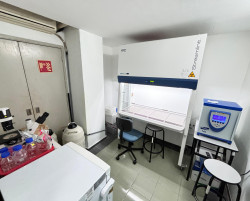
Cell culture room
A cell culture room is a room where a biosafety cabinet is used to manipulate infectious agents or cell cultures from various animals or plants. Isolating tissue culture operations from the enclosed lab reduces the risk of contamination of mammalian cell cultures and random exposure to biohazards.
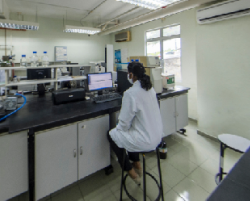
Special Instruments Room
A facility that has high end laboratory equipments to further analyze, quantify and detect elements in the pharmaceutical compound prepared

Animal Holding Room
A facility to temporarily house laboratory animals for hands on physiological and pharmacological practicals on live animals
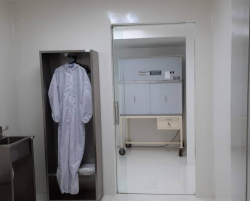
Simulated Clean Room
A facility that mimics the clean room facilities available in pharmaceutical manufacturing industries, allowing students to practice and learn the necessary skills of aseptic preparation of pharmaceutical compounds.
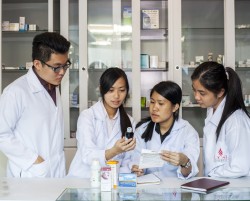
Simulated Community Pharmacy Lab
This lab was specifically designed for students to practice their skills in patient counselling and medication dispensing as pharmacists in training.
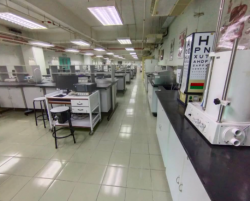
Pharmacy Practice Lab
The Pharmacy Practice Lab is used by students to practice and master their drug compounding and preparation skills in various dosage forms, including the injectables before entering the workforce. A new cleanroom facility is included in this lab.
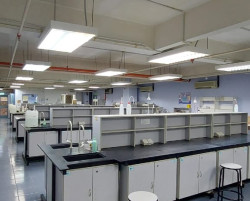
Pharmacy Project Lab
This lab is used to train students on the technology of drug formulation, formulation evaluation and quality assurance of drugs. UCSI pharmacy students have the option of undertaking a research project and this lab was purpose built to facilitate that.
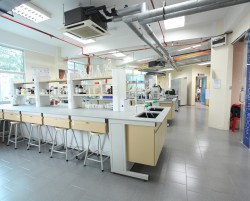
Pharmacy Postgraduate Lab
A dedicated Pharmacy Postgraduate Lab was launched in 2011 to facilitate cutting-edge research. The lab is equipped with advanced facilities like high performance liquid chromatography (HPLC), Fourier transform infrared spectroscopy (FT-IR), and UV-Visible spectrometer, among others.
Equipment
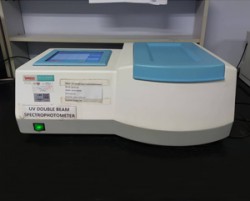
UV-Vis Spectrophotometer (Double Beam) Spectrum SP-UV 500DB
The SP-UV 500 is a double beam spectrophotometer in the production series of Spectrum Instruments. It gets a technology patent - "space separated double beam, Non-Symmetric vertical optical path". Compared with traditional double beam technology, simplified optical path improves reliability. The "width narrow and depth deep" design saves placement room.
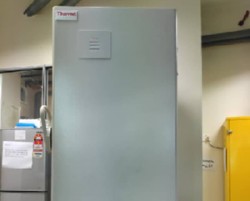
Thermo Scientific Forma 700 Series (-80oC)
Thermo Scientific Forma 700 Series offers reliable performance and no-frills functionality. These basic -80°C chest freezers feature an information center with programmable controls, temperature display, and an optional chart recorder or datalogger built into the base. Sublids for holding temperature are standard.
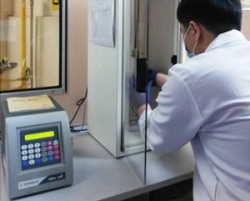
Sonics & Materials VCX 500 Ultrasonic Homogenizer
The process of applying sound energy to agitate particles or discontinuous fibers in a liquid is known as sonication and since ultrasonic frequencies (>20 kHz) are usually used, the process is also known as ultrasonication. Ultrasonication may be used for the preparation of nanoparticle materials and graphene dispersions, cell lysing, sample preparation, homogenization, ChIP Assay, emulsification, disaggregation and deagglomeration as well as various uses in sonochemical processing.
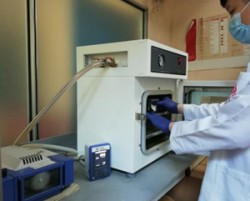
Taisite DZ-1BCIV Vacuum Drying Oven with IKA VC 10 Vacuum Controller
Vacuum drying operates under vacuum and allows the removal of moisture at controlled low temperatures, conferring the advantages over other drying processes such as having higher drying rate, lower drying temperature, and oxygen-deficient processing environment. It has been widely applied in various industries including pharmaceutical, food, plastics and textile industries. Vacuum drying oven which is also known as vacuum dryer or vacuum oven is specially designed for drying heat sensitive, easily decomposed and easily oxidized substances as well as for removing flammable solvents.
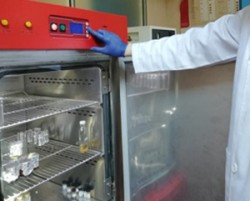
Capromax M200 Stability Chamber
Stability testing of pharmaceutical products is a routine procedure conducted at various stages of product development for the prediction of shelf life, determination of proper storage conditions and recommendation of appropriate labelling instructions. Accelerated stability testing is usually used in early stages to determine the type of degradation products that may be found after long storage whereas shelf life and expiration dates may be determined by testing under less rigorous conditions. Stability chambers are widely employed in pharmaceutical laboratory, clinical trials, environmental simulation, material testing and ICH stability studies to create extremely stable temperature and humidity environments inside a closed cabinet for the analysis of the effects of pre-specified conditions on drugs, biological samples, electronic components and even industrial machine parts.
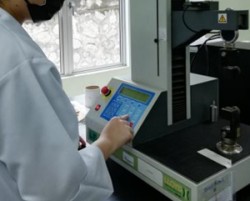
Lloyd LF Plus Tensile Tester
Tensile properties are often measured during the development of new materials and various processes to allow comparison, quality assurance as well as for the prediction of material behaviour under forms of loading other than uniaxial tension. Tensile strength tester is employed for various materials including plastic plates, tubes, profiles, plastic film, rubber, steel and fabric for their mechanical properties. Combining modern electronic technology with mechanical transmission technology, wide range of measurement, high precision and fast response can be provided by the tensile strength tester.
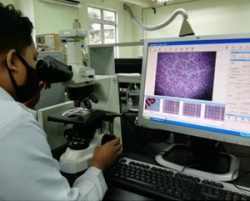
Nikon Eclipse 50i Microscope
Using visible light and a system of lenses to magnify images of small sample, optical microscopy allows the close viewing of samples at micron and submicron level investigations in various disciplines such as geology, medicine, and manufacturing. Advances in optical microscopy enables the visualization of submicron structures, determination of the surface profiles, and observation of selected cross sections of transparent materials without cutting the sample into thin slices.
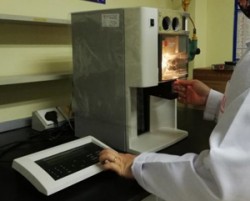
Beckman Coulter Z1 Dual Threshold Coulter Counter
The Coulter counter is a method of counting and sizing based on the detection and measurement of changes in conductance produced by a particle or cell suspended in a conductive liquid upon a sample passing through a pinhole. Beckman Coulter Z1 Dual Threshold Coulter Counter is a general laboratory use instrument which can be used to determine the human and animal cell count and concentration. It is employed for the analysis of particles in liquids only. With Coulter counter, cell counting is possible together with information about the cell size. Particles or cells suspended in a conductive liquid function as discrete insulators and when a dilute suspension of particles traverse the aperture substantially one at a time, each particle passage displaces electrolyte within the aperture, momentarily changes the resistance between the two electrodes located on each side of the aperture and produces a voltage pulse of magnitude proportional to particle volume for counting and sizing.
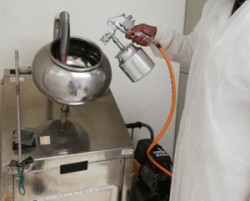
Electrolab ECP-12 Sugar Coating Machine
Coating is the process of applying an essentially dry, outer layer of coating material to the surface of a dosage form to confer specific advantages such as taste masking, odour masking, physical and chemical protection, protection against stomach acid, as well as to control the drug release profile. Coating may be applied to various oral solid dosage forms including tablets and granules.
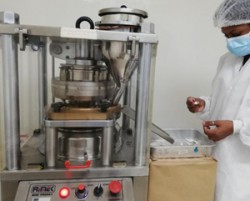
Karnavati Mini Press 1 Lab Scale Tablet Press Machine
Tablet is a popular and versatile dosage form with advantages of ease of manufacturing, convenient administration, accurate dosing and stability compared with oral liquids, tamper proofness compared with capsules as well as safe compared with parenteral dosage forms. A tablet press or tablet compression machine is used to compress powder material or granules into tablets of uniform size, shape and weight by the combined pressing action of two punches and a die. Single and multi stationary tablet press are the two types of tablet press machines currently used for the production of tablets.
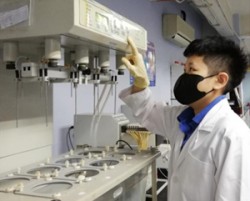
Electrolab TDT-08L Dissolution Tester
The process by which a solid solute enters a solution is known as dissolution. Dissolution test is an official test used by pharmacopeia to evaluate drug release of solid and semisolid dosage forms. It is an in vitro performance test procedure routinely performed for the quality control of oral solid dosage forms such as immediate or sustained release tablets and capsules, and its use has broadened to a variety of novel dosage forms.
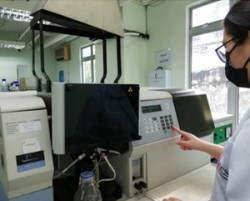
Perkin Elmer AAnalyst 100 Atomic Absorption Spectrometer
Atomic Absorption Spectrometry (AAS) is a technique based on the absorption of atomic spectral lines by the gas-phase atoms in their ground electronic states. It is employed to measure the quantities of chemical elements present in liquid or solid samples by measuring the absorbed radiation by the chemical element of interest. AAS is widely used in clinical chemistry laboratories for the analysis of various metals, including trace elements.
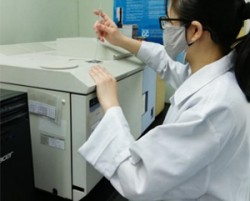
PerkinElmer Autosystem XL Gas Chromatography
Gas chromatography (GC) is a chromatographic technique applying a gas as the mobile phase and solid or liquid as the stationary phase to analyze volatile substances in the gas phase. Chromatography allows the separation of components in a sample and it has become one of the most widely used techniques in modern analytical chemistry with various applications including food analysis, quality control, research and forensics. GC has gained popularity in analytical chemistry due to its very high selectivity and resolution, good accuracy and precision, wide dynamic concentration range, and high sensitivity
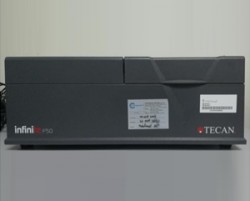
Tecan Infinite® F50 Absorbance Microplate Reader
An absorbance microplate reader, or absorbance reader is able to detect and quantify the light photons absorbed or transmitted by a liquid sample in a microplate which typically consist of 96 wells, when the sample is exposed to light at a specific wavelength. The absorbance is an absolute measurement quantified in Optical Densities (ODs), the logarithmic ratio between intensity of light falling upon the material and the intensity of the light transmitted through the sample. Absorbance readers can be applied in various fields, such as academic life science research, drug discovery and screening, clinical laboratories, synthetic biology and food or water quality monitoring.
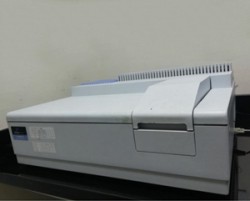
PerkinElmer LAMBDA™ 25 UV/Vis Spectrophotometer
Ultraviolet and visible light (UV/Vis) spectroscopy is a technique based on the absorption of light by a sample. The sample is illuminated with electromagnetic rays of wavelengths in the visible and ultraviolet and part of the lower infrared region (near IR) of the spectrum. Depending on the substance, light is partially absorbed and the transmitted light is recorded as a function of wavelength by a detector, providing the UV/Vis spectrum of sample. Each substance absorbs light differently, and the amount of absorbed light is related to the amount of sample, thus a specific relationship exists between the substance and its UV/Vis spectrum, which can then be used to identify or quantify a substance.
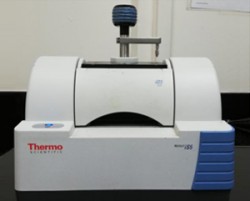
Thermo Scientific™ Nicolet™ iS™ 5 Fourier-Transform Infrared Spectroscopy (FTIR) Spectrometer
Fourier-transform infrared spectroscopy (FTIR) is the preferred method of infrared (IR) spectroscopy. An IR spectrum represents a fingerprint of a sample and since each different material is a unique combination of atoms, no exact same IR spectrum is produced by two compounds. This allows the identification (qualitative analysis) of every different type of material. Moreover, the size of the peaks in the spectrum directly indicates the amount of material present for quantitative analysis.
Want to know more? Contact us today!
About UCSI
Admissions
Life @ UCSI






